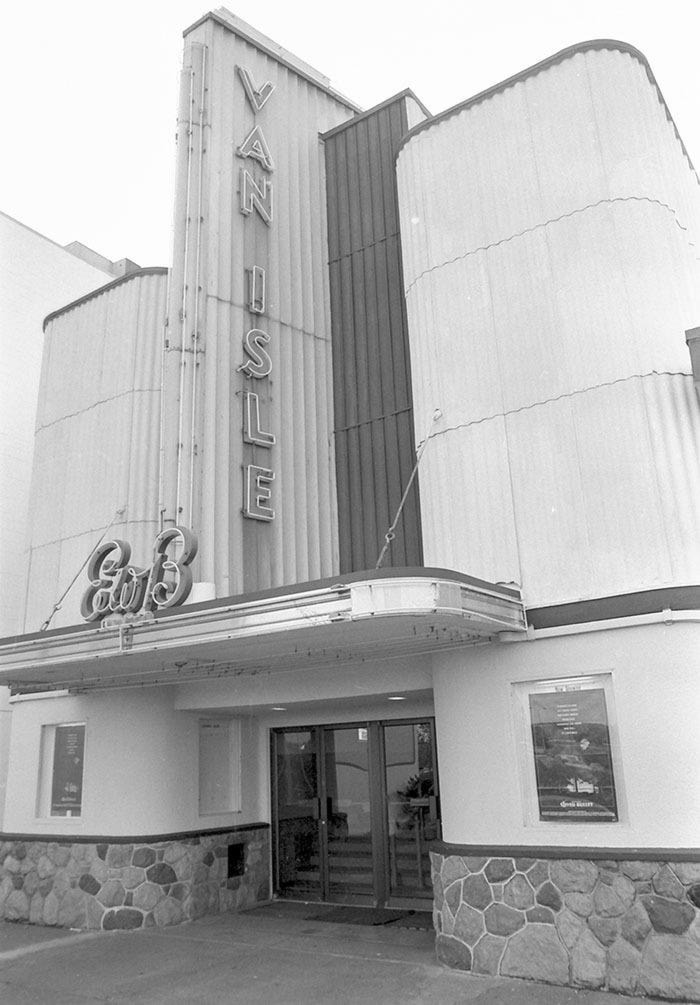The year 1947 brought an exciting change to Campbell River, then a village of 2,200 people, when the Van Isle Theatre opened its doors and made a real cinema available to residents for the first time.
The new theatre offered a movie every night of the week except Sunday, plus a matinee on Saturday afternoons. Each film ran for three consecutive evenings before being replaced by a new one.
The Van Isle Theatre was an impressive building. Modern in style, the Van Isle’s exterior combined Art Deco design and Streamline curved architecture. Inside was a spacious, comfortable lobby with a ticket booth and a candy counter, and in the theatre itself 599 seats faced the wide screen.
While stars such as Cary Grant, Loretta Young, Rita Hayworth and Orson Wells graced the screen, the Van Isle also was the setting for live productions. One of the first was a three-act comedy Here Comes Charlie presented by the local “Rotary Anns” in April 1948.
Concerts also took place in the theatre. Live classical music was heard when the Campbell River Kinsmen Club sponsored a presentation by the Courtenay Concert Orchestra.
The Van Isle’s popularity as an entertainment centre was equally enjoyed as a place where people met and visited before the show. Noreen Heggie, manager of the theatre for many years, noted, “People would come not just for the movies but for the socializing. They would come early to sit around in the big lobby, to see people they hadn’t seen in ages.”
In 1953, the newspaper announced the “World Premiere” of the film Country Magistrate, to be seen “for the first time anywhere” in the Van Isle Theatre. The National Film Board documentary, filmed in Campbell River, featured Roderick Haig-Brown and included many local people. The gala premiere was attended by such special guests as the province’s deputy attorney-general, the RCMP assistant commissioner and several other magistrates, and the show was pronounced to be a thoroughly good film.
Two “blockbuster” shows, Dr. Zhivago and The Sound of Music, fetched the higher than usual admission fee of $2 for adults, $1.50 for students and $1 for children, in 1968. Regular admission at that time, for a film such as To Sir With Love starring Sidney Poitier, was $1.25 for adults.
The theatre was always open at Christmas.
“Mr. Bickle (the owner) thought it was important that people have someplace to go,” said Sherry Heggie, daughter of the manager. Her mother would decorate the theatre and there was always a Christmas tree.
Sherry and her brother spent a lot of time at the Van Isle, helping with a variety of tasks like cleaning, taking tickets and ushering. Even her dog took part, “He cleaned up the Smarties that were dropped on the floor. That was his job.”
The Van Isle served Campbell River’s moviegoers for almost four decades, but television, home video rentals and new distribution rights; as well as the arrival of a new twin theatre, all had a negative impact on the theatre business. Happily, the Van Isle took on a new role in the life of the community when in 1987, it was converted into a performing arts theatre and reopened as the Tidemark, as welcome a development to the citizens of Campbell River as the cinema had been 40 years before.
For a glimpse at the past, be sure to visit the Museum at Campbell River’s Van Isle theatre, which with its rose-coloured velvet curtains and plum walls is reminiscent of the art deco style of the original Van Isle theatre and features three films: Fisherman’s Fall, featuring Roderick Haig-Brown, The Big Rock Story and The Destruction of Ripple Rock.
